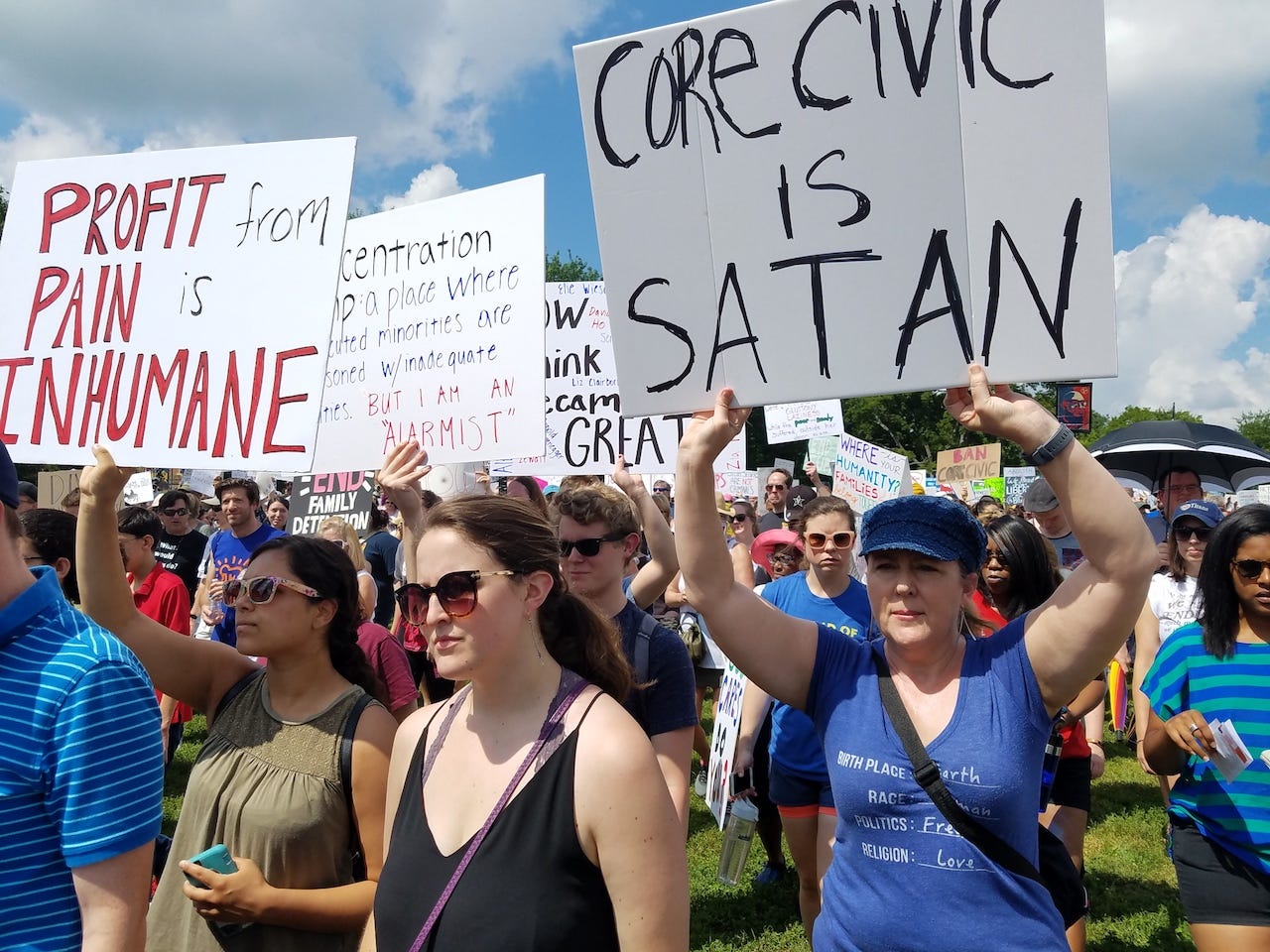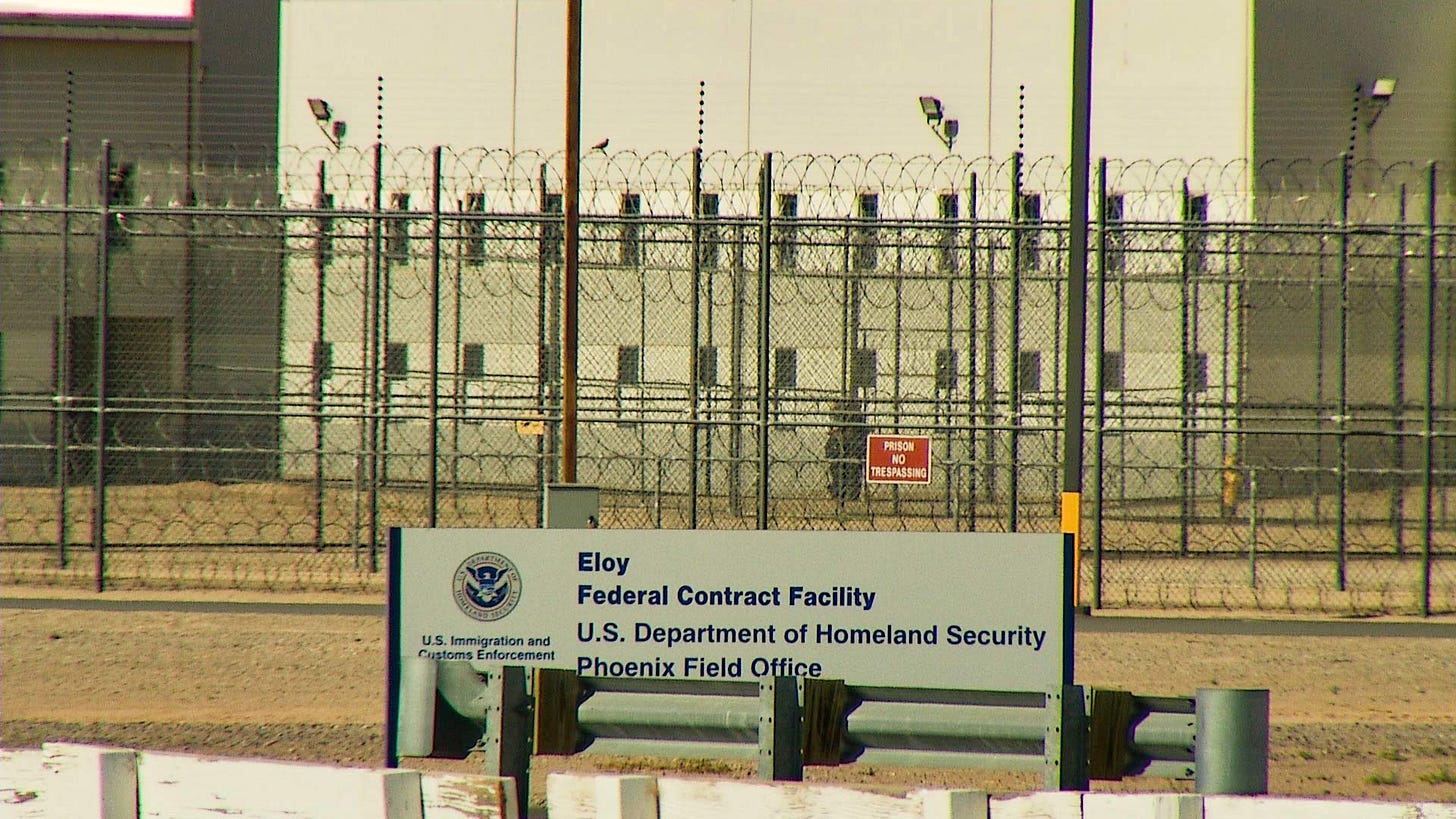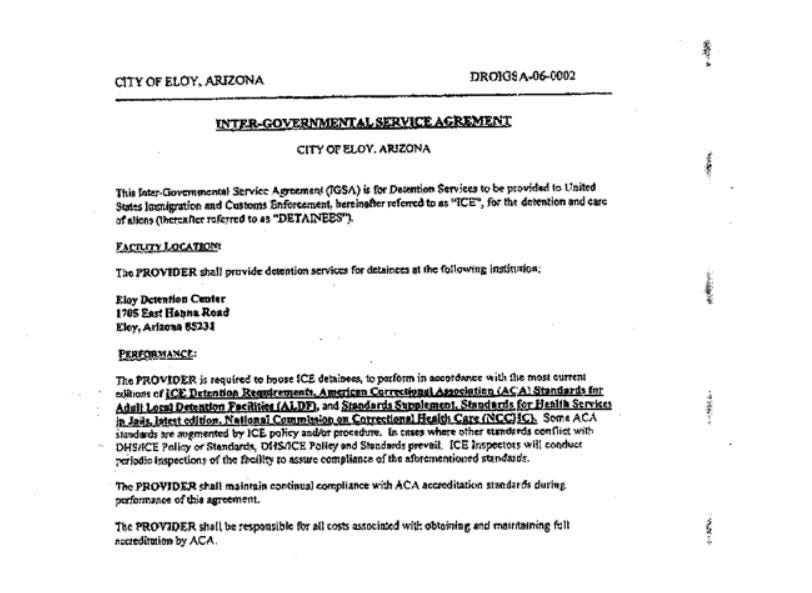The Eloy Triangle, Part I – Follow the Money
A look inside an asylum hearing at the ICE Eloy Detention Center
When I was in high school in Tucson, my friend Claude Bart wrote an article for our short-lived Comedy Club newspaper about how … like planes and ships off the coast of Bermuda, Florida and Costa Rica … random objects and even a person had disappeared entering a three-way intersection in the remote, rural town of Eloy, Arizona.
He called it “The Eloy Triangle” … another place in the middle of nowhere (between Phoenix and Tucson in the Sonoran desert) where people and things went never to be seen again.
We were high school kids trying to be funny. And maybe we were.
I hadn’t thought about it in years until yesterday when a friend drove two of us to support a man going through his political asylum hearing at the Eloy Detention Center … a place where people routinely entered never to be seen in this country again.
It was a powerful, terrifying and even profoundly moving experience. Too much to write about in one article. So … for the next four days I’ll be exploring different aspects of what I witnessed and welcome your own experiences and thoughts.
Part I – Follow the Money
Why Eloy?
Well over half of all ICE detainees are confined in large facilities at least 60 miles from the nearest major city. That might not even include the Eloy Detention Center, which is a mere 50 miles from Tucson … but still a two-hour round trip by car.
I had noticed this fact several years ago when I had to drive 85 miles each way to take part in a protest outside the Adelanto ICE Processing Center in the Mojave desert.
Why? Some simple research shows a mixture of political and economic reasons.
*Land is cheap in rural areas, which keeps construction costs down.
*Rural communities have significant job decline and a for-profit detention corporation can therefore:
-pitch a detention center that might otherwise be undesirable as “economic development”
-bring hundreds of jobs to the town and surrounding region.
-enter into “intergovernmental service agreements” (IGSA) with ICE or private prison corporations, receiving per-detainee payments. This can represent a major revenue stream for communities with shrinking tax bases.
It also has some added political benefits.
*Rural areas tend to be more conservative and face less political opposition to the projects … and also require long travel for people in cities to come protest at them, making mass protests less likely.
*Once the community is dependent on the for-profit detention corporation for its economic base it is much more likely community members will be to be hostile to any attempt to shut the detention center down. (CoreCivic, which runs the Eloy Detention Center, is the city’s largest employer, with nearly 10% of the city’s population – 1,546 of 15,600 – working at the Detention Center)
Again … and it’s hard to think this isn’t by design … the very rural communities that are becoming more at-risk by the cuts to medicare that are closing small town and rural health centers are – precisely because of that vulnerability – increasingly vulnerable targets to have large detention center corporations prey on their despair.
And there is one more important consequence to placing these detention facilities in remote areas. You see, unlike U.S. citizens who the sixth amendment right to an attorney, People applying for asylum or people without documentation trying to stay in this country can only be represented by legal counsel at their own expense.
Unlike in criminal cases, the government is not required to provide a free attorney if the person cannot afford one. This rule comes from the Immigration and Nationality Act (INA 240(b)(4)(A)) and explicitly states that it must be “at no expense to the government”
Like most other attorneys, most immigration lawyers live in major urban areas, making it far more difficult for them to take on even paying clients … and even more difficult to offer pro bono assistance … to someone detained more than a two-hour round trip away.
As a result, according to the American Immigration Council’s 2025 report, just 14% of detained immigrants have legal counsel.
Why Eloy? It’s cheap. It’s economically vulnerable. It’s conservative.
And … by separating detainees from potential legal counsel it helps bring the vision Acting Ice Director Todd Lyons articulated at the 2025 Border Security Expo up the road in Phoenix when he said:
Not just “like a business”
Like our prison systems, ICE detention in this country isn’t just “like a business” … it absolutely is a business.
I mentioned above the IGSAs … these are profit-sharing agreements between counties or other governmental entities and for-profit companies. The $11.25 billion added to ICE’s annual detention budget in that godawful budget bill (a 400% increase from last year)? This is where it is going.
As we follow the money, we discover a carefully-designed system to use struggling small towns as contractual middlemen.
First, as is usually helpful, a little history:
In 1952, the Immigration and Nationality Act (INA … often called the McCarran-Walter Act) was enacted. Some important things to note about this act.1
1) Before INA immigration law was scattered across dozens of statutes (e.g. the Chinese Exclusion Act, Immigration Acts of 1917, 1924, etc.). INA became an umbrella statute creating a single reference point for everything regarding immigration.
2) Because 1952 was the height of the Cold War, the act prioritizes screening for ideological and security risks, making any affiliation with “totalitarian” organizations grounds for exclusion or deportation.
3) It preserved the national origins quota system first established in 1924, which heavily favors Northern and Western European immigrants while restrixcting those from Asia, Africa and Southern/Eastern Europe.2
4) It ended race as a bar to naturalization. Before INA, only “free white persons” and people of African descent could naturalize. While leaving other barriers in place, INA removed explicit racial restrictions,
5) Perhaps most important to today’s situation, INA gave broad powers to the Executive Branch in exercising deportation authority. This was first through the Attorney General and later transferred to DHS/ICE and USCIS. This authority includes not only detention and deportation but contracting with state/local governments for detention – the basis for IGSAs
Now the original intent of allowing IGSAs was so the government could rent existing space in unused detention facilities without going through a lengthy procurement process. The first for-profit prison corporation (Corrections Corporation of America … which is now CoreCivic) wasn’t founded until 1983.
And, for-profit corporations like CoreCivic and GeoGroup – are now the primary beneficiaries.
How does the money flow?
1) ICE signs an IGSA with a small, struggling rural town like Eloy
2) ICE pays Eloy millions of dollars directly.
3) After taking an “administrative fee” Eloy subcontracts operations to a for-profit prison corporation (in this case, CoreCivic)3
4) CoreCivic gets a per diem amount for each detainee in the facility each day. The per diem for Eloy is $180/day. If yesterday (census 1146) was an average day, that means $75.29 million annually to Core City for the Eloy Detention Center alone.
In other words, ICE doesn’t pay the corporation directly but uses the economically strapped town as a pass through.
Why?
*It basically eliminates federal oversight. If ICE were to contract with CoreCivic directly they would have to go through what’s called the Federal Acquisition Regulation (FAR) contracting process, which takes time, requires competitive bidding, transparency and oversight. The GAO can audit and Congress can scrutinize the deals. Under an IGSA, the city of Eloy is the contracting body and there is almost no federal oversight.
*It lets the federal government distance itself from any abuse while tying local governments directly to the facility. The government can say “that’s not our contract” … while a small, struggling community is unlikely to protest something that is its economic bedrock and much fewer people are going to travel long distances to protest something that isn’t in their backyard.
So how IS business?
Booming.

Let’s just take CoreCivic, which runs the Eloy Detention Center.
Likewise, CoreCivic’s stock is up 52% over the past year.
And … you get what you pay for.
In addition, CoreCivic made a $500,000 contribution to the Trump–Vance inaugural committee in late 2024.
Business is booming … and it will continue to. Remember that 400% increase in budget to $11.25 billion … that’s all going to these corporations and the poor communities we are using as middlemen.
Coming soon to a poor, rural community (not) near you
Since Trump took office, these facilities have either been opened or are planned.
In addition, the Washington Post reports that internal ICE documents (updated as of July 30, 2025) show plans to double detention capacity to more than 107,000 beds and that ICE is considering 125 new or expanded facilities, including mega-centers, tent camps and at least two family detention centers.
What can we do?
First, be informed and spread the word. I have tried to source as much of the information as possible. Fact check me. Add more. Spread the word so more and more people know the big money that is behind the inhumanity.
Second, if you are fortunate enough to have investments, make sure that none of your mutual funds or other investments include any of these for-profit prison and detention center corporations. Yes, they are making money … but it’s blood money.
Look for these names:
CoreCivic
GEO Group
Management & Training Corporation (MTC)
LaSalle Corrections
Immigration Centers of America (ICA)
Third … and this is where movement building comes in. If part of the fuel driving this engine is the economic vulnerability of small communities … think about how we can support these communities in other ways and give them alternatives.
Are there ways that corporations that are good citizens (Costco?) could come in and build distribution centers?
Are there other ways organizations like the Episcopal Church can use stockholder resolutions to support communities that are targeted for this soul-killing “economic development?”
The Eloy Triangle is real … for one thing, millions and millions of our tax dollars go there and disappear into the pockets of corporations like CoreCivic.
And … that’s not all that disappears. Tomorrow, we will look at the experience of being a detainee.
President Truman actually vetoed the act (before the veto was quickly overturned by Congress), saying: ““This bill repudiates our basic national policy and our heritage of fair treatment to all peoples regardless of race, color, or creed…. The basis of this bill is the infamous national origins quota system, which discriminates, deliberately and intentionally, against many of the peoples of the world…. In no other realm of our national life are we so hampered and stultified by the dead hand of the past, as we are in this field of immigration… In enacting this bill, we are deliberately branding ourselves as one of the very few countries in the world which continues to discriminate in the admission of immigrants on the basis of race and national origin.”
The quota system was finally abolished in 1965 by the Hart–Celler Act.
Because Eloy already had an IGSA with ICE, the city was tapped in 2014 to serve as a contractual middleman for the South Texas Family Residential Center in Dilley, Texas. Under this modified IGSA, ICE paid Eloy approximately $438,000 annually solely for this intermediary role.






Excellent work, Mike. I'm posting on TRMS BlueSky account.
Mike, thank you for this excellent journalism/storytelling/call for prophetic action. Let me know when you're gonna be here next so we can do happy hour together.